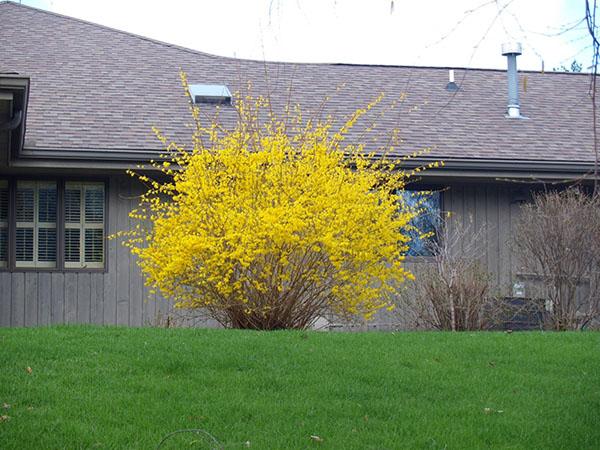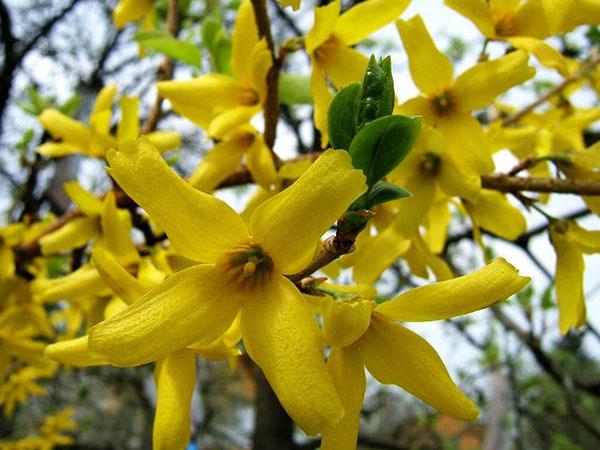Yellow forsythia shrub - a bright decoration of the garden
 The change of seasons on earth causes an unimaginable delight among many, especially flora lovers. When a yellow forsythia bush blooms in the garden, they know that spring has come. With the first rays of the sun, this amazing plant puts on a bright fiery outfit of many flowers. They completely cover the crop even before the greenery appears. Against the background of gloomy trees, the plant seems to inform that the awakening of nature is not far off.
The change of seasons on earth causes an unimaginable delight among many, especially flora lovers. When a yellow forsythia bush blooms in the garden, they know that spring has come. With the first rays of the sun, this amazing plant puts on a bright fiery outfit of many flowers. They completely cover the crop even before the greenery appears. Against the background of gloomy trees, the plant seems to inform that the awakening of nature is not far off.
Currently, the yellow forsythia shrub has won the hearts of many creative summer residents. Therefore, the plant appeared on many household plots. What is it? What varieties are in demand among fans of suburban gardening? How to care for a shrub so that it is always pleasing to the eye? Consider the answers to these questions in order to grow the spring highlight of the garden in our country house.
Biological features of the original culture

 The size of the buds reaches about 3 cm in diameter. After successful pollination, the bells turn into original fruits. They are capsules filled with winged seeds.
The size of the buds reaches about 3 cm in diameter. After successful pollination, the bells turn into original fruits. They are capsules filled with winged seeds.
The shrub is propagated using seeds, layers and cuttings.
 The yellow forsythia shrub is considered a close relative of the famous olive. This is indicated by the unique shape of the serrated leaf plates. In length they can be from 2 to 15 cm. Their surface is painted green, which changes its shade in the sun. Thus, the shrubs retain their attractiveness throughout the season. During the "lush wilting nature", the leaves of the culture turn crimson, and it takes on a unique appearance.
The yellow forsythia shrub is considered a close relative of the famous olive. This is indicated by the unique shape of the serrated leaf plates. In length they can be from 2 to 15 cm. Their surface is painted green, which changes its shade in the sun. Thus, the shrubs retain their attractiveness throughout the season. During the "lush wilting nature", the leaves of the culture turn crimson, and it takes on a unique appearance.
Yellow bush forsythia at their summer cottage
 Today, there are several types of brightly flowering spring plants. Some were bred in Asia, others were raised in Europe. Let's get acquainted with some of them.
Today, there are several types of brightly flowering spring plants. Some were bred in Asia, others were raised in Europe. Let's get acquainted with some of them.
Drooping or weeping forsythia
 The variety takes root wonderfully in mountainous areas. Therefore, it is mainly grown in the Caucasus or the Crimean peninsula. The main feature of the culture is hanging shoots, strewn with many buds in early spring. The maximum flower size is approximately 2.5 cm.
The variety takes root wonderfully in mountainous areas. Therefore, it is mainly grown in the Caucasus or the Crimean peninsula. The main feature of the culture is hanging shoots, strewn with many buds in early spring. The maximum flower size is approximately 2.5 cm.
In the southern regions of Russia, you can grow the Greenest variety, which has an original coloring of the leaf plates.
Forsythia Linwood
 For areas with a cold climate, a frost-resistant variety that can withstand temperatures down to 20 ° C is suitable. Linwood not only tolerates the vagaries of nature, but also feels great in the urban area. In early spring, the yellow forsythia bush announces the departure of winter, raising the spirits of fans of green spaces.
For areas with a cold climate, a frost-resistant variety that can withstand temperatures down to 20 ° C is suitable. Linwood not only tolerates the vagaries of nature, but also feels great in the urban area. In early spring, the yellow forsythia bush announces the departure of winter, raising the spirits of fans of green spaces.
Forsythia Ovate
 The shrub will grow no more than 2 m, therefore it is widely used for arrangement hedge... In early spring, bright single yellow buds bloom on graceful shoots. The variety is actively cultivated in Siberia to decorate personal plots.
The shrub will grow no more than 2 m, therefore it is widely used for arrangement hedge... In early spring, bright single yellow buds bloom on graceful shoots. The variety is actively cultivated in Siberia to decorate personal plots.
Forsythia Giralda
 This variety is suitable for central Russia, as well as the Ural region.Light yellow buds, about 2 cm in size, bloom in early spring. They are collected in small inflorescences of 2 or 3 pieces. The shrub is used to create original landscapes in summer cottages or city parks.
This variety is suitable for central Russia, as well as the Ural region.Light yellow buds, about 2 cm in size, bloom in early spring. They are collected in small inflorescences of 2 or 3 pieces. The shrub is used to create original landscapes in summer cottages or city parks.
Features of plant care
 Like any culture, the yellow-flowered forsythia bush needs attention from the gardener.
Like any culture, the yellow-flowered forsythia bush needs attention from the gardener.
It includes simple steps:
- regular hydration;
- top dressing;
- planned pruning;
- protection from disease and pests.
Typically, a mature plant does not need to be watered frequently. However, during the dry period, forsythia needs additional moisture (10 liters of water once every 3 weeks). After watering, the root zone is mulched, keeping the water level in the soil. Thanks to this, the plant will look juicy and beautiful.
To speed up the flowering of the culture, it is regularly fed. Fertilizers are applied during the first thaw, when the buds are forming. The second time feed is added to the soil after the appearance of greenery on the shoots.
Approximately 50 or 60 g of complex mineral dressing is applied per 1 m² of land.
 To make the shrub look presentable, it is pruned every year. To begin with, remove dry and damaged branches. The procedure is performed at the end of winter before the beginning of bud formation. If the crop is used as a hedge, additional pruning may be required.
To make the shrub look presentable, it is pruned every year. To begin with, remove dry and damaged branches. The procedure is performed at the end of winter before the beginning of bud formation. If the crop is used as a hedge, additional pruning may be required.
Compared to other garden plants, forsythia is disease resistant. If, when planting the culture, the bottom of the funnel is not laid drainage, rot may appear in the roots. To remove it, the bush is dug up, after which the damaged parts of the root system are removed. Then the plant is transplanted to a new place where there is a lot of light, providing it with high-quality drainage. As a result, a forsythia bush with yellow flowers will tirelessly notify people of the arrival of spring.